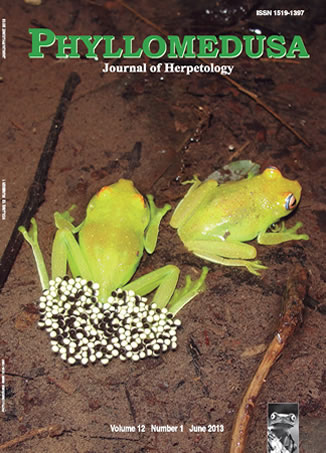Nest structure, incubation and hatching in the Trinidadian leaf-frog Phyllomedusa trinitatis (Anura: Hylidae)
DOI:
https://doi.org/10.11606/issn.2316-9079.v12i1p13-32Keywords:
Agalychnis, hatching, leafnests, Phyllomedusinae.Abstract
New findings on nesting and hatching are reported for the leaf-nesting tree frog Phyllomedusa trinitatis. Nest height and leaf cover (one or many leaves; well or poorly covered) were very variable. Contrary to a previous report, eggless jelly capsules were scattered amongst the eggs, with substantial jelly plugs located above and below the egg clutch. Plugs were composed of capsules embedded in a matrix of somewhat different composition. The upper plug acted as a barrier to water entry. Contrary to previous reports, isolated eggs could develop in aquatic media, the later stage on entry the better: aeration and salt composition of the water influenced this ability. Egg clutches developed equally well whether the covering leaves were alive or dead. Single eggs incubated in water hatched prematurely; when placed in water, eggs near hatching stage hatched within a short time; such eggs on a dry or damp substrate did not hatch till much later. The hatching of any embryo in a group appeared to act as a stimulus to neighbours to hatch. Observations on nests with the covering leaves replaced by clingfilm showed that emergence is preceded by a lengthy period of hatching behavior, with individuals hatching, wriggling and stimulating larger and larger groups to hatch, and releasing a frothy fluid which leads to the dissolution of the lower jelly plug and emergence of the hatchlings. Contrary to a previous report, hatching gland cells were observable on the laterodorsal surface of the head. When hatchlings emerged from the nest, they were mostly at Gosner stage 25 with gills fully resorbed. When earlier embryos were induced to hatch, they rapidly shortened their external gills. These findings are discussed in comparison with observations on the related genus Agalychnis.Downloads
Download data is not yet available.
Downloads
Published
2013-06-18
Issue
Section
Articles
License
All material originally published in Phyllomedusa belongs to Escola Superior de Agricultura Luiz de Queiroz - Universidade de São Paulo. All contents are under a license of Creative Commons BY-NC-ND.How to Cite
Downie, J. R., Nokhbatolfoghahai, M., Bruce, D., Smith, J. M., Orthmann-Brask, N., & MacDonald-Allan, I. (2013). Nest structure, incubation and hatching in the Trinidadian leaf-frog Phyllomedusa trinitatis (Anura: Hylidae). Phyllomedusa: Journal of Herpetology, 12(1), 13-32. https://doi.org/10.11606/issn.2316-9079.v12i1p13-32



 Impact Factor (JCR): 0.600
Impact Factor (JCR): 0.600 CiteScore: 1.0
CiteScore: 1.0